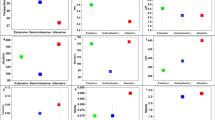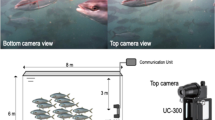Abstract
Oyster condition measures should be standardized through use of Hopkins’ formula: Condition Index = (dry meat weight in g) (100)/(internal cavity volume in cm3). Cavity volumes, previously measured chiefly as capacity by a water displacement method, may be determined by subtracting the weight in air of the oyster’s valves from the weight in air of the intact oyster (both in g). This method is valid because the effective density of cavity contents is close to 1g per cm3. The technique is simple and time-efficient and could promote more widespread use of oyster condition studies.
Similar content being viewed by others
Literature Cited
Andrews, J. D. 1961. Measurement of shell growth in oysters by weighing in water.Proc. Natl. Shellfish. Assoc. 52:1–11.
Baird, R. H. 1958. Measurement of condition in mussels and oysters.J. Cons., Cons. Int. Explor. Mer. 23:249–257.
Cunningham, P. A., andM. R. Tripp. 1975. Accumulation, tissue distribution, and elimination of203HgCl2 and Ch3 203 HgCl in the tissue of the American oysterCrassostrea virginica.Mar. Biol. 31:321–334.
Frazier, J. M. 1975. The dynamics of metals in the Americna oyster,Crassostrea virginica. I. Seasonal effects.Chesapeake Sci. 16:162–171.
Frazier, J. M. 1976. The dynamics of metals in the American oyster,Crassostrea virginica II. Environmental effects.Chesapeake Sci. 17:188–197.
Galtsoff, P. S. 1964. The American oysterCrassostrea virginica Gmelin.U. S., Fish Wildl. Serv., Fish. Bull. 64, 480 p.
Galtsoff, P. S., andW. Arcisz. 1954. Observations on the rate of propulsion of water and retention of coliform bacteria by the oyster.Proc. Natl. Shellfish. Assoc. 44:1–8.
Galtsoff, P. S., W. A. Chipman, J. B. Engle, andH. N. Calderwood. 1947. Ecological and physiological studies of the effect of sulfate pulp mill waste on oysters in the York River, Virginia.U. S. Fish Wildl. Serv., Fish. Bull. 43, 51:59–186.
Grave, C. (ed.). 1912. A manual of oyster culture in Maryland. Board Shellfish Comm. Maryland, 4th Rep., p. 279–348.
Haven, D. 1961. Seasonal cycle of condition index of oysters in the York and Rappahannock Rivers.Proc. Natl. Shellfish. Assoc. 52:42–66.
Havinga, B. 1928. The daily rate of growth of oysters during summer.J. Cons., Cons. Int. Explor. Mer. 3:231–245.
Higgins, E. 1938. Progress in biological inquiries, 1937. U.S. Comm. Fish. Rep. 1938, App. 1, p. 1–70.
Hopkins, A. E. 1949. Determination of condition of oysters.Science 110:567–568.
Korringa, P. 1955. Qualitätsbestimmungen an Miesmuscheln und Austern.Arch. Fischereiwiss. 6:189–193.
Lowe, J. I., P. R. Parrish, J. M. Patrick, Jr., andJ. Forrester. 1972. Effects of the polychlorinated biphenyl Arochlor® 1254 on the American oysterCrassostrea virginica.Mar. Biol. 17:209–214.
Mann, R. 1977. Some biochemical and physiological aspects of growth and gametogenesis inCrassostrea gigas (Thumberg) andOstrea edulis L. grown at sustained elevated temperatures. unpubl. ms. Woods Hole Oceanogr. Inst. WHOI-77-59.
Quayle, D. B. 1950. The seasonal growth of the Pacific oysters (Ostrea gigas) in Ladysmith Harbour. British Columbia Dept. Fish. Rep. 1950, p. 85–90.
Ruddy, G. M., S. Y. Feng, andG. S. Campbell. 1975. The effect of prolonged exposure to elevated temperatures on the biochemical constituents, gonadal development, and shell deposition of the American oysterCrassostrea virginica.Comp. Biochem. Physiol. 51B:157–164.
Scott, G. I., andD. R. Lawrence. 1982. The American oyster as a coastal zone pollution monitor: A pilot study.Estuaries 5:27–33.
Scott, G. I., andD. R. Middaugh. 1978. Seasonal chronic toxicity of chlorination to the American oyster,Crassostrea virginica, p. 311–328.In Ann Arbor Science Publ. Inc., Water Chlorination: Vol. 2, Environmental Impact and Health Effects. Ann Arbor, Michigan.
Scott, G. I., andW. B. Vernberg. 1979. Co-occurring chlorine produced oxidants in seawater and their effect on the growth, survival, and physiology of the American oyster,Crassostrea virginica (Gmelin). Evidence for synergistic effects with seasonal temperature stress, p. 415–435.In W. B. Vernberg, F. Thurberg, A. Calabreese, and F. J. Vernberg (eds.), Marine Pollution: Functional Responses. Academic Press, New York.
Westley, R. E. 1961. Selection and evaluation of a quantitative measurement of oyster condition.Proc. Nat. Shellfish. Ass. 50:145–149.
Author information
Authors and Affiliations
Additional information
Contribution No. 363 of the Belle W. Baruch Institute for Marine Biology and Coastal Research; Contribution No. 81 of the Gulf Breeze Environmental Research Laboratory.
Rights and permissions
About this article
Cite this article
Lawrence, D.R., Scott, G.I. The determination and use of condition index of oysters. Estuaries 5, 23–27 (1982). https://doi.org/10.2307/1352213
Issue Date:
DOI: https://doi.org/10.2307/1352213




